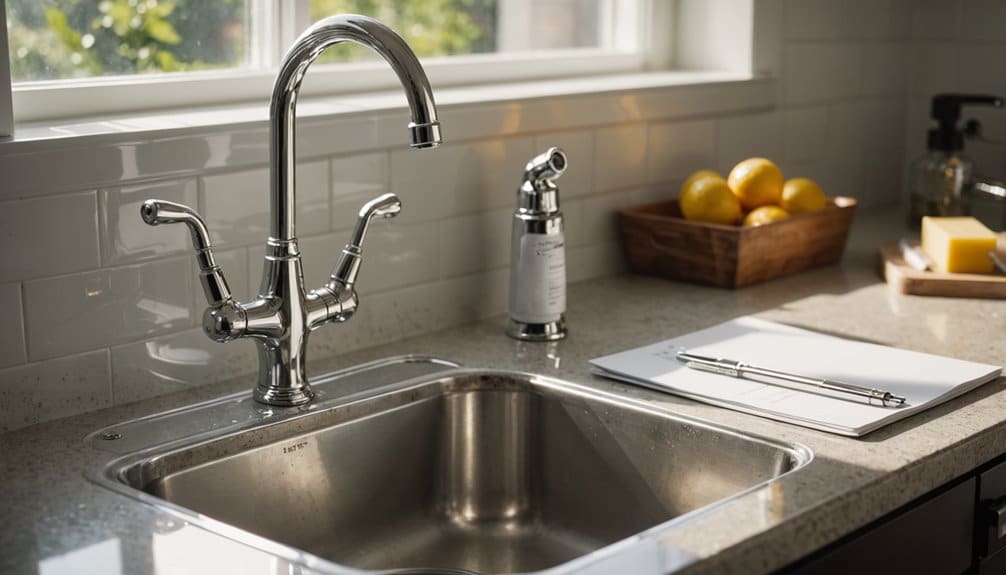A vital home inspection checklist for buyers includes critical assessments of the basement and crawl space, roof and attic, and exterior structure. Inspect plumbing and electrical systems for functionality and safety. A thorough HVAC system overview guarantees efficient heating and cooling. Safety features, property drainage considerations, and a final walkthrough are also crucial. Each component plays a role in safeguarding the investment, revealing potential issues before purchase. Further details improve understanding of these fundamental elements.
Comprehensive Morgando Realty Services Home Inspection ChecklistKey Takeaways
- Assess the structural integrity by evaluating the foundation, roof, and attic for signs of damage or deterioration.
- Inspect plumbing and electrical systems for leaks, corrosion, and safety compliance to ensure proper functionality.
- Examine interior rooms for water damage, cracks, and the operational state of doors and windows.
- Check HVAC systems for efficiency, including verifying air quality equipment and ductwork conditions.
- Verify safety features like smoke detectors, carbon monoxide detectors, and fire extinguisher accessibility for compliance with local codes.
Basement and Crawl Space Assessment
A thorough assessment of the basement and crawl space is critical for potential homebuyers, as these areas can significantly impact the total integrity of the home. The home inspection checklist for buyers should prioritize checking for water intrusion from foundation cracks and plumbing leaks. Mold growth must be assessed through visual inspections and testing kits, and humidity levels must be evaluated to determine the need for dehumidifiers. Proper drainage systems must be examined to prevent pooling. Furthermore, the adequacy of ventilation should be scrutinized to guarantee compliance with codes and efficient airflow, mitigating moisture issues. Understanding property tax implications is also essential, as problems in these areas can affect overall home value and future expenses. A comprehensive evaluation addresses both immediate concerns and long-term stability, guiding buyers in making informed decisions for their future homes. Regular inspections help ensure that the crawl space remains free from moisture control issues that could affect the home’s overall condition.
Roof and Attic Evaluation
A thorough evaluation of the roof and attic is vital for prospective homebuyers, as these components play a significant role in the overall performance and lifespan of the property. Inspectors should assess the roof exterior for missing or damaged shingles, deteriorated flashing, and signs of moisture retention, such as algae growth. Structural integrity demands attention to sagging roof decks and gaps that allow daylight penetration. In the attic, verifying proper insulation R-value and coverage is imperative, along with checking for moisture damage or mold. Regular inspections of ventilation and airflow systems must ensure they function adequately, with unobstructed vents preventing temperature imbalances. Identifying water stains, damp insulation, or active leaks further guarantees long-term comfort and safety, protecting the buyer’s investment.
Exterior Structure Examination

The exterior structure examination focuses on three critical areas: foundation integrity, drainage patterns, and siding condition. Evaluating the foundation involves checking for structural stability and signs of deterioration, while drainage patterns must guarantee effective water management away from the property. Furthermore, assessing the siding’s condition is crucial to identifying potential weather-related damage and verifying proper installation. Inspectors examine major systems to ensure that any issues can be addressed before finalizing the purchase.
Foundation Integrity Assessment
Evaluating the foundation integrity is crucial in determining a property’s general stability and safety. Prospective buyers should thoroughly inspect the foundation for potential issues that could signify deeper problems.
- Cracks and Damage: Look for visible cracks in walls or foundations, signs of uneven settling, and evidence of water penetration, such as stains and mineral deposits. Be aware that hidden issues may also exist that could affect the overall condition of the home.
- Vegetation Proximity: Assess nearby trees and overgrown shrubs that might threaten the foundation through encroaching roots.
- External Material Condition: Examine for rotting wood, decayed siding, or deteriorating joints that could compromise the foundation’s integrity. A Seller’s Inspection Checklist helps to identify and resolve these issues before a property is listed.
Addressing these key factors can prevent future repair costs and provide peace of mind to buyers regarding their investment in a new home.
Drainage Patterns Evaluation
Evaluating drainage patterns is vital in ensuring proper exterior water management around a property. A thorough inspection should begin with gutters and downspouts, ensuring they are free from debris and effectively directing water at least ten feet from the foundation. The lot grading must incline away from the home, eliminating the risk of standing water. Moreover, all surfaces, such as driveways and patios, should be intact to prevent water from converging toward the structure. Stormwater management systems require verification, as clear drains and functional swales are essential for directing runoff. Any signs of erosion or compromised drainage, such as water pooling, may indicate deeper issues that need addressing to protect the property’s integrity. Additionally, it’s essential to conduct regular sump pump maintenance to ensure they are functioning correctly and effectively preventing basement flooding.
Siding Condition Inspection
A thorough inspection of the siding condition is essential for identifying potential vulnerabilities in a property’s exterior structure. The siding not only improves aesthetics but also protects against environmental elements. Buyers should consider the following areas during their assessment:
- Visible Damage: Look for cracks, chips, or loose sections that may indicate wear and tear.
- Material-Specific Defects: Different siding materials have distinct issues; wood may show rot, whereas vinyl might have dents or bowing.
- Moisture-Related Degradation: Signs of mold, water stains, or swollen panels suggest hidden water intrusion. Regular siding inspections can help catch these issues before they escalate.
Plumbing Systems Inspection

Thorough inspection of plumbing systems is crucial for prospective home buyers, as it can reveal potential issues that may not be immediately visible. Inspectors check for visible leaks in exposed pipes and fixtures, while also evaluating pipe conditions for corrosion or outdated materials. Water pressure is examined across diverse fixtures to guarantee proper function. The age and condition of the water heater are vital, with recommendations for replacement if it is 10 to 15 years old. Additionally, conducting a professional plumbing inspection ensures that hidden plumbing issues are uncovered, providing deeper insights into the home’s plumbing health. Drain and sewer systems require testing for clogs and odors, and it is significant to inspect toilets, faucets, and tubs for functionality and leaks. Proper installation and maintenance standards of all plumbing components contribute markedly to a home’s overall integrity and safety.
Electrical Systems Review
How does one guarantee the safety and functionality of a home’s electrical system? A thorough Electrical Systems Review is imperative for potential homeowners. Several key aspects drive this evaluation.
- Electrical Panel Inspection: Ascertain that service entrance wires are intact and the central panel is accessible, properly mounted, and free from signs of corrosion or overheating.
- Branch Circuit Wiring & Safety: Examine wiring for damage or inappropriate gauge, confirming all junction boxes are secure and compliant with safety standards.
- Safety Devices & Code Compliance: Verify GFCIs and AFCIs are present in required areas and function correctly, adhering to NEC regulations.
Interior Rooms Analysis

When analyzing interior rooms, potential homeowners must pay careful attention to diverse structural and functional elements that could impact the thorough integrity and livability of the space. Evaluating surfaces is vital; walls and ceilings should be inspected for straightness and visible cracks, which may indicate underlying issues. Water damage or plumbing leaks can significantly affect the overall health of a home. Moreover, the operation and alignment of doors and windows should be tested to guarantee proper function and insulation. Flooring conditions must be assessed, with attention to any damage or safety concerns. Ultimately, examining features such as fireplaces and smoke detectors is essential, as they contribute to a safe, welcoming environment for any family.
HVAC System Overview
Evaluating the HVAC system is vital for prospective homeowners, as it greatly influences comfort and energy efficiency. A thorough inspection guarantees that the heating and cooling components function at their best and contribute to a healthier living environment. Key areas to focus on include:
- Heating System: Inspect the burner assembly, verify heat exchanger condition, and assess thermostat settings.
- Cooling System: Check the condenser coil integrity, confirm refrigerant levels are balanced, and test compressor functionality.
- Air Quality: Assess air filter condition, inspect ductwork for damage, and evaluate the efficiency of air quality equipment.
Safety Features Check

The assessment of safety features is essential for ensuring the protection of occupants in a home. This includes testing the functionality of smoke detectors and confirming the presence and operational status of carbon monoxide detectors, as both are important for early hazard detection. Furthermore, an evaluation of fire extinguisher accessibility will determine whether residents can respond effectively in case of fire emergencies.
Smoke Detector Functionality
Home buyers must pay close attention to the functionality of smoke detectors, as these devices are crucial for safety within residential properties. A thorough inspection should entail the following:
- Location Compliance: Verify smoke detectors are installed on every level, including basement hallways, to adhere to local safety regulations.
- Functional Testing: Inspect smoke detectors for operational status, checking for missing batteries or outdated models, as units older than ten years pose safety risks.
- Legal Requirements: Verify the property meets all fire safety regulations; details may vary by state, with some requiring documented compliance for home sales.
Carbon Monoxide Detectors
Smoke detectors play an essential role in fire safety, but carbon monoxide detectors are likewise significant for safeguarding against the hidden dangers of this colorless, odorless gas. Homebuyers should verify that carbon monoxide detectors are present, compliant, and functional throughout the property.
| Aspect | Requirement | Frequency |
|---|---|---|
| Placement | Near sleeping areas | At installation |
| Testing | Monthly functional tests | Monthly |
| Battery Replacement | Every 6 months | Semi-annual |
| Professional Testing | When symptoms present | As needed |
| Certification | Fire department proof required | Before sale |
Attention to these details can improve safety and fulfill legal requirements, underscoring the importance of thorough inspections in protecting loved ones from the risk of carbon monoxide exposure.
Fire Extinguisher Accessibility
Ensuring fire extinguisher accessibility is a critical safety consideration for homebuyers, as it directly impacts the effectiveness of emergency response in the event of a fire. To improve safety features, buyers should evaluate the following:
- Mounting Height: Extinguishers should be installed with operable parts no higher than 48 inches and at least 15 inches from the floor to accommodate all users, including those with disabilities.
- Visibility and Access: Extinguishers must be wall-mounted in clear sightlines, free from obstructions for immediate access.
- Local Compliance: Buyers should verify adherence to local fire codes, ensuring that extinguisher locations are compliant with OSHA, NFPA, and ADA standards for maximum safety and functionality.
Property Drainage Considerations

A thorough evaluation of property drainage systems is essential for prospective buyers, as efadequaterainage plays a pivotal role in preventing water-related damage. Key areas to investigate include sewer line integrity, stormwater management, and general grading.
| Drainage Element | Inspection Focus |
|---|---|
| Sewer Line | Check for blockages or root intrusions using camera technology. |
| Stormwater Management | Verify the installation of rain gutters and downspouts. |
| Downspout Placement | Confirm discharge is at least 10 feet from foundations. |
| Surface Runoff Patterns | Inspect for erosion or puddling near structures. |
| Cleanout Access | Confirm the accessibility of sewer line cleanouts. |
Attention to these details can save buyers from unforeseen problems, providing peace of mind in their investment.
Final Walkthrough Tips
During the final walkthrough, it is imperative to verify the functionality of all systems and appliances within the home. Buyers should methodically check for any damage and ascertain that fixtures and items included in the purchase are intact and operational. This thorough inspection will help identify any discrepancies or issues that require attention before finalizing the transaction. Additionally, understanding local regulations can provide insights into potential compliance issues that may arise post-purchase.
Verify Functioning Systems
Verifying the functionality of vital systems is a critical step during the final walkthrough of a home. Prospective buyers should guarantee all systems are in good working order, which helps foster a sense of belonging in their new space. Focusing on the following key areas will provide peace of mind:
- Plumbing Systems: Check for leaks and guarantee water flow at faucets, toilets, and drains.
- HVAC Systems: Test thermostat settings, verify airflow, and run both heating and cooling systems for consistent performance.
- Electrical Systems: Guarantee light switches, outlets, smoke detectors, and GFCI outlets are fully operational.
Conducting these checks can alleviate future worries and improve the complete experience of homeownership.
Check for Damage
Thorough examination of the property for potential damage is vital in the final walkthrough process. Buyers should meticulously inspect the physical structure for any new cracks, movement, or water stains on walls, ceilings, and floors. Baseboards and crown molding should be assessed for recent caulk or paint repairs. Furthermore, testing doors and windows for proper operation, including opening, closing, and locking mechanisms, is indispensable. Uncovering hidden areas, such as attics and basements, requires checking for any signs of new damage or leaks. Finally, verifying that all appliances are undamaged and operational, along with confirming completion of requested repairs and inclusions, solidifies the buyer’s assurance before finalizing the purchase. Additionally, understanding how seller concessions can be negotiated may help mitigate costs associated with any necessary repairs discovered during the inspection. Careful attention to detail guarantees a smoother shift into their new home.
Frequently Asked Questions
What Should I Look for in the Home’s Foundation?
When evaluating a home’s foundation, examine cracks, bulging, and crumbling surfaces. Consider drainage issues, standing water, and proximity to vegetation. Inspect for signs of leakage around doors and windows, as these can indicate structural concerns or moisture problems.
How Often Should I Inspect the HVAC System?
The recommended HVAC inspection frequency varies: biannually guarantees seasonal readiness, annually provides baseline maintenance, while older or heavily used systems benefit from increased checks. Regular assessments optimize performance, prolong lifespan, and improve energy efficiency.
What Should I Know About Electrical Panel Safety?
Outdated or overloaded electrical panels can pose serious fire hazards and may not meet modern codes. Look for signs of corrosion, burnt odors, or fuses instead of breakers—these are red flags that require professional attention.
Are There Any Signs of Pest Infestations to Check For?
What hidden dangers might pests present in a home? Observing droppings, gnaw marks, nests, or mud tubes can indicate infestations. Addressing these signs early guarantees comfort and safety, fostering a sense of belonging within the space.
What Is the Age of the Roof and Its Materials?
The age of the roof and its materials greatly influence longevity. Asphalt shingles may last 15-30 years, while metal can extend up to 80 years, highlighting the need for evaluations of installation quality and local climate impacts for accuracy.
How Can I Determine the Water Pressure in the Home?
To determine water pressure, one should attach a pressure gauge to the outdoor hose bib, conduct hydrostatic and static leak tests, and measure flow rates using a jug and timer, to ensure accurate and reliable results.
Conclusion
In traversing the intricate tapestry of homebuying, a thorough inspection serves as a prudent guardian against unforeseen pitfalls. By meticulously evaluating each component—from the depths of the basement to the peaks of the roof—the discerning buyer can uncover the subtle whispers of potential issues. Consequently, this vital checklist not only illuminates the property’s hidden narratives but also equips buyers to commence their new expedition with confidence and assurance, safeguarding their investment for years to come.
References
- https://www.homedepot.com/c/ab/home-inspection-checklist/9ba683603be9fa5395fab901b69aa18e
- https://www.bettagroup.co.nz/the-essential-home-inspection-checklist-what-every-buyer-and-seller-needs-to-know/
- https://www.rocketmortgage.com/learn/home-inspection-checklist
- https://totalhomeinspection.com/TotalHomeInspectionChecklist.pdf
- https://better.com/content/home-inspection-checklist
- https://safetyculture.com/checklists/crawl-space-inspection/
- https://eliteinspections.com/what-crawl-space-inspectors-look-for-during-an-inspection/
- https://www.nachi.org/under-floor-crawl-space.htm
- https://vfsworks.com/blog/crawl-space-inspection-checklist/
- https://crawlspaceninja.com/blog/spring-crawl-space-maintenance-checklist/







